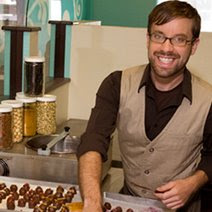Chocolate Anatomy and the Eclipse Pantry
Around mid-January, I started to respond to a few people who were looking to purchase high-quality chocolate and other ingredients that we use in our production line. Beyond taking a trip to Whole Foods and other specialty stores, it can be quite hard to source great chocolate for your own culinary needs. Let me tell you... what an upgrade I made when I was first able to place orders with chocolate-makers direct! Now my orders hover around 500 pounds with each delivery. Quite a lot of chocolate!
All the chocolate we use is couveture chocolate, meaning that it contains very high amounts of cocoa butter. Chocolate, if you are unaware, is an emulsion of cocoa liquor (the dark content of the cocoa bean), cocoa butter (the natural fat from the cocoa bean), sugar (cane, in this case), and trace amounts of vanilla and soy lecithin (a natural emulsifier found in all chocolate). If you heard me speak on These Day with Tom Fudge around V-day, you would have listened to me drone on about my personal interest in couveture chocolates and high-quality white and milk chocolates. Seriously... it's become a bit of a personal quest of mine to educated the world! I can't tell you how common it is for someone to stop into the cafe and try one of my white chocolates and respond that though they have always disliked it before, they just can't eat enough! Very briefly, milk chocolate has the same components as dark chocolate with the addition of milk powder, while white chocolate omits the cocoa liquor altogether which is why is has no chocolate color. Sounds easy enough, right?
Well the tricky issue is in discussing the cocoa butter content of these chocolates. When purchasing good chocolate, you should see a percentage listed on the package (and don't buy any without!). It seems pretty logical to take this percentage listed at face value and while that's a good place to start it's just a beginning. Most people will see a 60% or 70% and assume the higher the better, right? Well yes and no! The higher the number the darker the chocolate, but it doesn't necessary indicate quality at all. According to regulations set by the USDA, that percentage indicates the total cocoa mass of the chocolate, which is the combined weight of both cocoa liquor and cocoa butter. But then what?
The cocoa liquor contributes flavor and the cocoa butter contributes texture. So while higher percentages often yield better chocolates, you may inadvertently be purchasing chocolate with very little cocoa butter content. In fact, some low-end white chocolates even contain amounts of vegetable fats instead, which lends a tooth and texture to the chocolate that is usually considered "hard and waxy". Being that it is also used in high-end cosmetics, this natural fat is the most expensive component of chocolate and manufacturers who need to produce "cheap" chocolate just can't afford much of it in their formulas.
So all of the chocolate we use is couveture chocolate (French for coating, because it's very fluid when melted), and since cocoa butter melts at body temperature the resulting chocolate is very creamy and unctuous in the mouth. Delicious!
And where can you find such a chocolate for your own personal use? Why, the new Eclipse Pantry section! Find a selection of high quality chocolates along with many many other specialty ingredients including:
Cocoa Nibs
Brute Cocoa Powder
Organic Lavender Blossoms
Our house-made Tarragon and Vanilla Bean Sugars
Cardamom Pods
Grains of Paradise
Vietnamese Cinnamon
Pink and White Peppercorns
And much more!
-










No comments:
Post a Comment